|
 |
|
 |
|
|
|
Jesus gave the above pledge to Peter in the
region of Caesarea Philippi, a city built
around an ancient cultic pagan site
dedicated to the Greek Roman god Pan. |
|
|
|
Pan was the god of the shepherds, their
flocks and their rustic music. He was
ugly. And even his mother agreed that
he was ugly. At his birth Pan's human
mother peered at the new-born with
astonishment. He had emerged human,
but only partly. He was half beast, with
little goat horns, goat hooves and a little
goat tail. This astonishment quickly
turned to horror and Pan's mother fled,
never to be seen again. |
|
|
|
The abandoned infant was rescued by his
divine father Hermes who whisked him off to
Mount Olympus, abode of the gods, where he
was warmly welcomed. As he grew, Pan
became a real charmer laughing, prancing
and dancing to the amusement and
entertainment of the gods. |
|
|
|
 |
|
Peter and
Pan exhibit at Israel Museum 2019 |
|
Sculptures of Pan, part
human part goat shown with little goat horns |
|
|
|
But he didn't live on the esteemed Mount
Olympus with the other gods. He dwelled in a
cave at the foot of the mount. Pan was
considered a protector of nature. He was god of the shepherds, their flocks and their
rustic music. He was often seen playing a
flute produced from hollow river reeds,
later named in his honor the pan-pipe. |
|
|
|
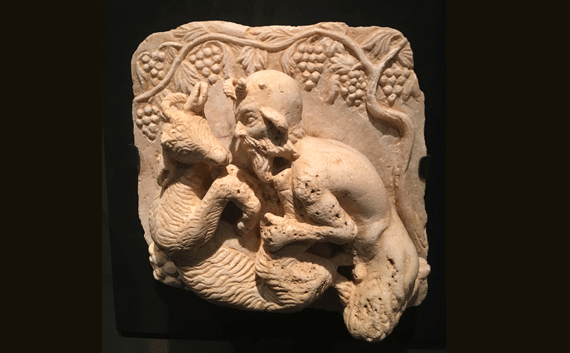 |
|
Peter and
Pan exhibit at Israel Museum 2019 |
|
Pan was a protector of
nature and shepherds |
|
|
|
It was said that Pan possessed a thunderous
voice which he once used at the Battle of
Marathon to aid the Athenians who were
fighting the Persians. When Pan emerged from
a nearby cave at a decisive moment and
roared, the Persians fled in absolute
terror, thus creating the word panic, from
Pan. |
|
|
|
Being a rustic god, Pan was not worshipped
in temples or in other built edifices, but
in natural settings, usually in caves or
grottoes such as one on the north slope of
the Acropolis in Athens.
|
|
|
|
So it was natural that from the third
century BC that a conspicuous cave on the
periphery of Galilee, the border between the
Jews and the pagans would become a focus for
the worship of Pan, the god of nature who
held sway in the border areas of
snow-covered ridges, dense thickets and
rock-cliff caves.
|
|
|
|
 |
|
Photo:
Gila Yudkin |
|
This cave above the Jordan
springs became a revered site of Pan worship |
|
|
|
Because of the cave the site became known as
Paneas, dedicated to Pan. We know from
artifacts found by excavators in the 1990s
that people would gather at the site to eat
and drink and make merry. Perhaps they would
even barbeque goat. (yum-yum??) They left
behind broken fragments of clay and glass
pots, cups and saucers along with lots of
goat bones for 20th century archeologists to
scrutinize.
|
|
|
|
 |
|
Peter and
Pan exhibit at Israel Museum 2019 |
|
Artifacts used by Pan
worshippers found by the late 20th century
excavators |
|
|
|
(A dozen glass and clay vessels from Paneas
are now on display at the Israel Museum in
Jerusalem. The exhibition has the catchy
title: "From Ancient Greece to Neverland:
Peter and Pan.") |
|
|
|
 |
|
Peter and
Pan exhibit at Israel Museum 2019 |
|
Pan worshippers would
gather at Paneas to eat, drink and make
merry |
|
|
|
More and more pilgrims flocking to the site
of Pan worship and all-night merriment
attracted vendors supplying services like
food, utensils, music, and perhaps even
souvenirs. First a street was built, lined
with shops. Then another street and another,
with residences for the vendors. Eventually
a city was established. |
|
|
|
The city was named Caesarea Philippi after
the founder, Philip, son of Herod the Great
and the Caesar Augustus, the current emperor
in Rome. (We know the city was founded in 2
BC because archeologists found a coin dated
98 AD with an inscription marking the
centennial celebration of the founding of
Caesarea Philippi.) |
|
|
|
 |
|
Photo:
Gila Yudkin |
|
Ruins of first century AD
Caesarea Philippi |
|
|
|
Matthew 16 says that Jesus brought his
disciples to the outskirts of Caesarea
Philippi. But why did Jesus choose such a
long trek from the center of his public
ministry at Capernaum? Perhaps it is related
to the nature of Pan and the physicality of
the site of Paneas.
|
|
|
|
Pan, with his human and animal nature
symbolizes duality humanity and
bestiality. Eventually Pan's physical
appearance his goat horns, goat tail and
cloven hooves becomes the artistic model
for the representation of the devil. And
Paneas with its hedonistic pagan rites had a
large cave believed to descend down into the
underworld. This may have been the perfect
place to contrast the gates of hell with the
kingdom of heaven. |
|
|
|
 |
|
Photo:
Gila Yudkin |
|
Gila is standing by the
first century AD niche dedicated to the God
Pan |
|
|
|
Jesus' disciples may have been shocked at
the sights and sounds of paganism running
rampant there. For these devout Jews, it may
have been like entering a red-light
district. As one pastor puts it, Caesarea
Philippi was a city of "people eagerly
knocking on the gates of hell." |
|
|
|
It was here that Jesus posed the challenging
question "Who do you say that I am?" To
which Peter boldly replied, "You are the son
of the living God." Here, the disciples were
confronted with the contrast of Jesus'
personification of hope with the darkness of
evil practices. At Caesarea Philippi, built
upon pagan values, the disciples could be
fortified for their mission of storming the
gates of hell |
|
|
|
It's here at Caesarea Philippi that the star
pupil Simon is renamed, like in a rebirth. He is born again as Peter bar Jonah. And
just like Jonah the prophet, Peter will be
charged with bringing the word of the Lord
to the Pagan world. |
|
|
|
When we tour Caesarea Philippi, we sit under
the shady fig trees and with the echo of the
Jordan headwaters gushing out of the rock,
we listen to Matthew 16. Then we climb up to
the cultic area to note the giant cave next
to the remains of the temple dedicated to
Pan. We'll see a niche for a statue of Pan
and the faint inscription dated 87 AD,
dedicated to Pan and the nymphs. |
|
|
|
 |
|
Photo:
Gila Yudkin |
|
Spring Scene at Paneas /
Caesarea Philippi / Banias |
|
|
|
We can wonder, was it here that Jesus stood
with his back facing the opening to the cave
which people believed led to the underworld,
Hades in Greek mythology, while he pointed
to the massive rock and blessed Peter,
speaking of the keys to the kingdom of
heaven? |
|
|
|
 |
|
Photo:
Gila Yudkin |
|
At Caesarea Philippi Jesus
blessed Peter and spoke of the kingdom of
heaven |
|
|
|
If you haven't yet visited Paneas / Caesarea
Philippi / Banias (its modern name
substitutes B for P) be sure to add it to
your bucket list. It's an evocative site to
stimulate your mind, senses (sight, sounds,
smell) and spirit.
|
|
|
|
Copyright 20019 Gila Yudkin. Permission
needed for any reuse. |
|
|
|
Gila
Yudkin calls herself a Connecticut-born Yankee
living in King David's court. When Gila
first started guiding 40 years ago, the cave
of Paneas hadn't yet been excavated. She was
an eye witness to the excavations and their
revelations. When you visit Caesarea
Philippi with Gila, remind her to tell the
story of the archeologist and the shrine of
the holy goats.
|
|
|
|
Caesarea Philippi was built by Herod Philip
at the northern border of his kingdom,
inherited from his father, Herod the Great.
He built another city called Bethsaida on
the southern boundary of his kingdom. Read
about
unexpected finds at Bethsaida.
First century AD historian Josephus tells us
that Philip died and was buried at
Bethsaida. Herod Philip's tomb has NOT yet
been found by archeologists. Stay tuned!!! |
|
|
|
Also in the vicinity of Caesarea Philippi,
along Israel's northern border, is
Tel Abel
Beth Maccah. This is where, a thousand years
before the time of Jesus, a "wise woman"
ended a revolt threatening David's regime.
(See Second Samuel 20) In June 2018 a
magnificent two-inch sculpture of a king's
head was discovered in a massive Iron Age
citadel dated to the ninth century BC. Read
about this
archeological biblical mystery.
|
|
|
|
COMING TO
THE HOLY LAND?
BOOK GILA for a customized private tour |
|
|
|
Have you Visited these biblical
sites in the Galilee? |
|
|
|
 |
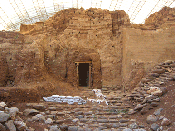 |
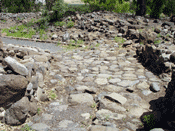 |
|
Joshua at Hatzor |
Abraham at Dan |
Peter's hometown Bethsaida |
|
|
|
|
 |
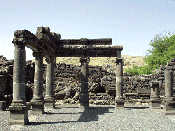 |
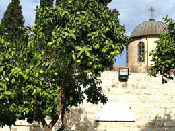 |
|
Who is this biblical king? |
Lament over Chorazin |
Wedding at Cana |

